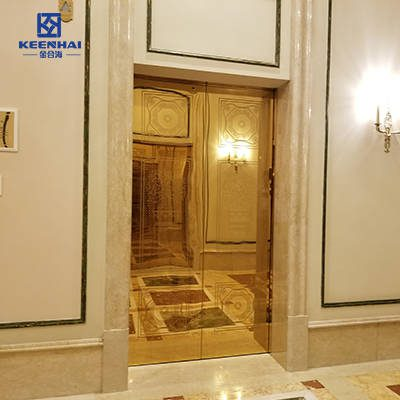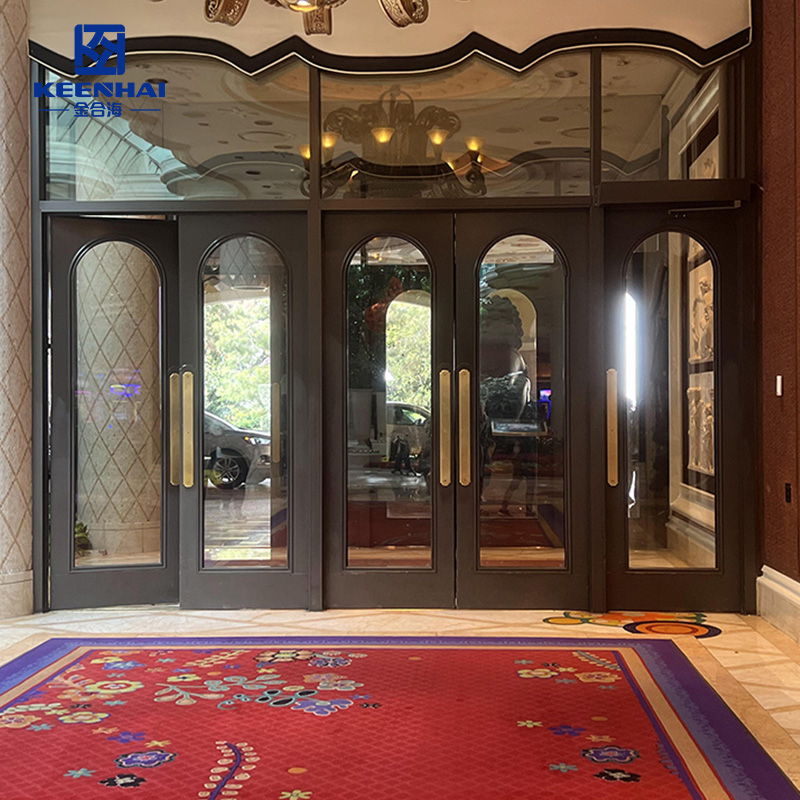Cost-wise, stainless steel doors range from $2,800–$6,500 per set with optional PVD finishes, while glass doors range $3,000–$5,500. Installation is slightly higher for glass due to protective handling. Considering durability, low maintenance, and aesthetic versatility, stainless steel elevator doors consistently outperform glass for both high-rise and high-traffic projects.
1.Material Strength and Durability
When selecting elevator doors, material strength and durability are the first things architects and building owners consider. Stainless steel elevator doors have become the go-to choice for high-traffic buildings because they combine corrosion resistance with long-term structural integrity. In contrast, glass doors, while visually appealing, are prone to scratches, chips, and cracking under repeated use.
1.1Corrosion and Rust Resistance
One major advantage of stainless steel is its resistance to corrosion and rust. Grade 304 stainless steel offers solid protection for most indoor environments, while grade 316 provides superior resistance in humid or coastal locations. This makes modern stainless steel elevator panels ideal for hotels, hospitals, and subway stations where moisture and cleaning chemicals are frequent.
Glass doors, although corrosion-free, often require additional coatings or tempered glass to prevent micro-fractures over time, increasing maintenance complexity.
1.2Impact and Wear Resistance in High-Traffic Areas
High-traffic elevators demand doors that can withstand constant opening, closing, and accidental bumps. Stainless steel excels in this regard, especially when reinforced with thicker gauge panels and PVD coatings. Glass doors, even tempered or laminated, tend to show scratches and cracks more quickly, which can lead to higher replacement costs.
Here’s a direct performance comparison for 2025:
| Fonctionnalité | Portes d'ascenseur en acier inoxydable | Glass Elevator Doors | Notes |
|---|---|---|---|
| Résistance à la corrosion | High (304–316 grade) | Moderate (requires coating) | Stainless steel lasts decades indoors/outdoors |
| Scratch/Impact Resistance | Haut | Low–Medium | Glass chips under heavy impact |
| Maintenance Frequency | Faible | Medium–High | Stainless steel only needs mild cleaning |
| Longevity in High-Traffic | 15–25 years | 7–12 years | Stainless steel often doubles service life |
| Cost Range | $2,800–$6,500 per set | $3,000–$5,500 per set | PVD-coated stainless can reach $7,000 for premium finish |
For example, a 10-story office building in Chicago recently installed 12 units of brushed stainless steel doors. Despite daily high usage, the doors showed minimal wear after 3 years, whereas a comparable glass installation in a shopping mall required partial panel replacement within 2 years.
This detailed comparison highlights why Entrées d'ascenseur en acier inoxydable are preferred for commercial and high-traffic residential projects. Choosing stainless steel not only ensures long-term durability but also minimizes ongoing maintenance, providing real cost savings over the building’s lifetime.
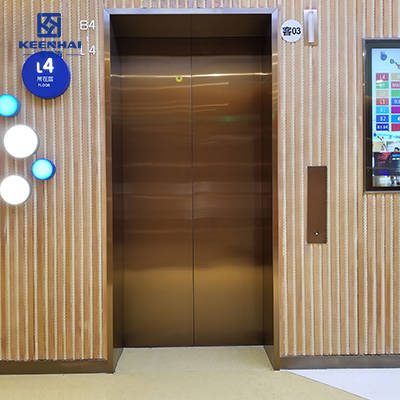
2. Cost Considerations
When deciding between stainless steel elevator doors and glass doors, cost is a major factor. Prices vary significantly depending on material grade, finish, size, and installation complexity. Understanding each cost component helps building owners make informed choices without overspending.
2.1 Initial Purchase Price Differences
The initial purchase price depends on the material, finish, and customization. For 2025:
-
Stainless Steel Doors: $2,800–$6,500 per set
-
Basic 304 hairline finish: ~$2,800
-
316 mirror finish or PVD-coated: $4,500–$6,500
-
-
Glass Doors: $3,000–$5,500 per set
-
Tempered or laminated panels with frame: $3,000–$4,200
-
Custom etched or reinforced panels: $4,500–$5,500
-
| Matériel | Base Price per Set | Custom Finish | Notes |
|---|---|---|---|
| Acier inoxydable | $2,800–$4,000 | PVD coating +$500–$1,500 | Durable, long-term investment |
| Glass | $3,000–$4,200 | Etching or reinforcement +$500–$1,300 | Aesthetically premium but prone to damage |
Tip: Choosing stainless steel lift doors with PVD coating may increase upfront cost, but reduces long-term replacement and maintenance expenses.
2.2 Installation and Labor Expenses
Installation costs depend on door weight, building height, and labor skill. For typical 10–15 floor commercial projects:
-
Stainless Steel Doors: $400–$900 per set
-
Heavy doors require additional hoisting equipment
-
Alignment and polishing are critical to prevent scratches
-
-
Glass Doors: $500–$1,000 per set
-
Requires precise handling to prevent cracks
-
Often needs protective coatings or reinforcement frames
-
Factors that influence labor costs:
-
Door dimensions and weight
-
Number of floors requiring coordinated installation
-
Presence of automatic opening mechanisms
-
Any decorative or custom finishes
Example: A 12-floor office in New York installed 15 sets of PVD-coated stainless steel elevator doors. Labor cost totaled $12,500 due to careful alignment, polishing, and protective transport handling. By contrast, a similar glass door installation of 10 units required $9,800 but included extra coating to prevent micro-fractures.
2.3 Total Cost Considerations
Combining purchase and installation:
| Door Type | Material Cost | Installation Cost | Total Range | Long-Term Notes |
|---|---|---|---|---|
| Acier inoxydable | $2,800–$6,500 | $400–$900 | $3,200–$7,400 | Minimal maintenance, lasts 15–25 years |
| Glass | $3,000–$5,500 | $500–$1,000 | $3,500–$6,500 | Higher repair and replacement frequency |
By evaluating both upfront and long-term costs, stainless steel doors often provide better value in high-traffic or commercial environments, particularly when using premium finishes like PVD or custom hairline/mirror options. Choosing the right material upfront saves thousands over the building lifecycle.
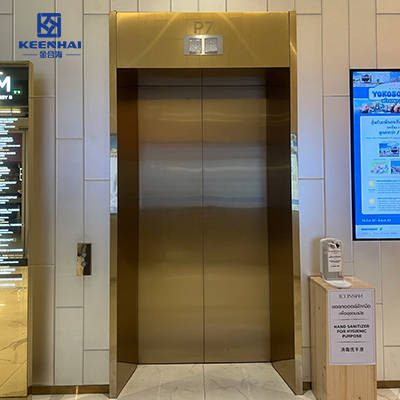
3. Maintenance and Longevity
Proper maintenance is crucial when comparing stainless steel elevator doors and glass doors. While stainless steel offers long-term durability with minimal upkeep, glass doors often require more frequent cleaning and careful handling to prevent scratches and cracks. Understanding these factors helps building managers plan both labor and replacement budgets effectively.
3.1 Cleaning Frequency and Methods
-
Stainless Steel Doors:
-
Recommended cleaning: once a week for high-traffic areas, bi-weekly for low-traffic.
-
Use mild detergent, soft cloths, and non-abrasive cleaners.
-
PVD-coated stainless steel doors can maintain their finish with minimal effort, resisting fingerprints and smudges.
-
-
Glass Doors:
-
Cleaning frequency: 2–3 times per week in commercial areas.
-
Requires specialized glass cleaners to avoid streaks and scratches.
-
Tempered glass reduces breakage risk but still needs careful handling.
-
| Door Type | Cleaning Frequency | Recommended Methods | Notes |
|---|---|---|---|
| Acier inoxydable | 1x/week (high traffic) | Soft cloth, mild detergent | PVD finish resists fingerprints |
| Glass | 2–3x/week | Glass cleaner, microfiber cloth | Prone to streaks and minor scratches |
Example: A 15-story office in Los Angeles using brushed stainless steel doors requires only 15 minutes per set per week for cleaning, whereas similar glass doors take 25–30 minutes per set due to streak removal and edge inspections.
3.2 Repair and Replacement Costs
-
Stainless Steel Doors: Rarely require replacement; minor dents or scratches can be polished out. Typical repair cost: $150–$400 per panel, depending on finish. Full replacement may range $2,800–$6,500 per set, but it’s infrequent.
-
Glass Doors: Chips, cracks, or scratches require panel replacement. Repair is often impractical, with $500–$1,200 per panel, and full replacement ranges $3,000–$5,500 per set.
Example: In a hotel elevator with daily high traffic, stainless steel doors installed 5 years ago still appear near-new, while a comparable glass door installation required partial panel replacement after 3 years, adding over $6,000 in maintenance and labor costs.
By prioritizing stainless steel lift doors, building owners reduce long-term labor, cleaning frequency, and unexpected repair costs, making them a more cost-effective choice for high-traffic commercial or residential projects.
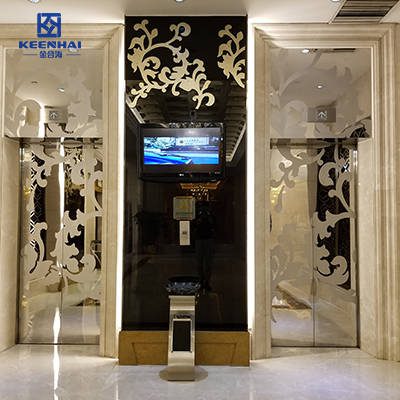
4. Aesthetic and Design Flexibility
Beyond durability and cost, aesthetic appeal and design flexibility are key when choosing elevator doors. Both stainless steel elevator doors and glass doors offer distinct visual benefits, but the choice often depends on building style, interior design, and desired user experience.
4.1 Visual Appeal and Finish Options
Stainless Steel Doors:
-
Available in hairline, mirror, PVD-coated, or custom brushed finishes.
-
Can be polished to match luxury interiors or textured for industrial designs.
-
PVD coatings allow gold, bronze, black, or copper tones, giving architects flexibility without compromising durability.
Glass Doors:
-
Offer transparent, frosted, tinted, or etched options.
-
Excellent for modern offices or lobbies, creating a sense of openness.
-
Decorative films or laminates can add color, patterns, or branding.
| Fonctionnalité | Portes d'ascenseur en acier inoxydable | Glass Elevator Doors | Notes |
|---|---|---|---|
| Finish Options | Hairline, Mirror, PVD-coated | Clear, Frosted, Tinted, Etched | Stainless steel offers metallic variety; glass allows transparency/customization |
| Fingerprint Resistance | High (especially PVD) | Faible | Glass requires frequent cleaning |
| Color Variety | Gold, Bronze, Black, Copper | Limited (via film/laminate) | Stainless steel maintains metallic tones long-term |
Example: In a Manhattan luxury apartment, developers chose brushed PVD-coated stainless steel doors to complement modern interiors, avoiding fingerprints and showing consistent metallic shine even after heavy daily use.
4.2 Integration with Building Interiors
-
Stainless Steel Doors: Blend seamlessly with metal railings, elevator frames, and modern furniture. Their reflective surface enhances lighting and can make lobbies appear larger.
-
Glass Doors: Provide a light, airy feel, visually connecting elevator cabins with open spaces. However, they can clash with metallic or dark-toned interiors if not carefully coordinated.
Tip: For mixed-use buildings, pairing Entrées d'ascenseur en acier inoxydable in high-traffic areas with glass doors in aesthetic lobbies can combine durability and visual openness, balancing cost, maintenance, and style.

